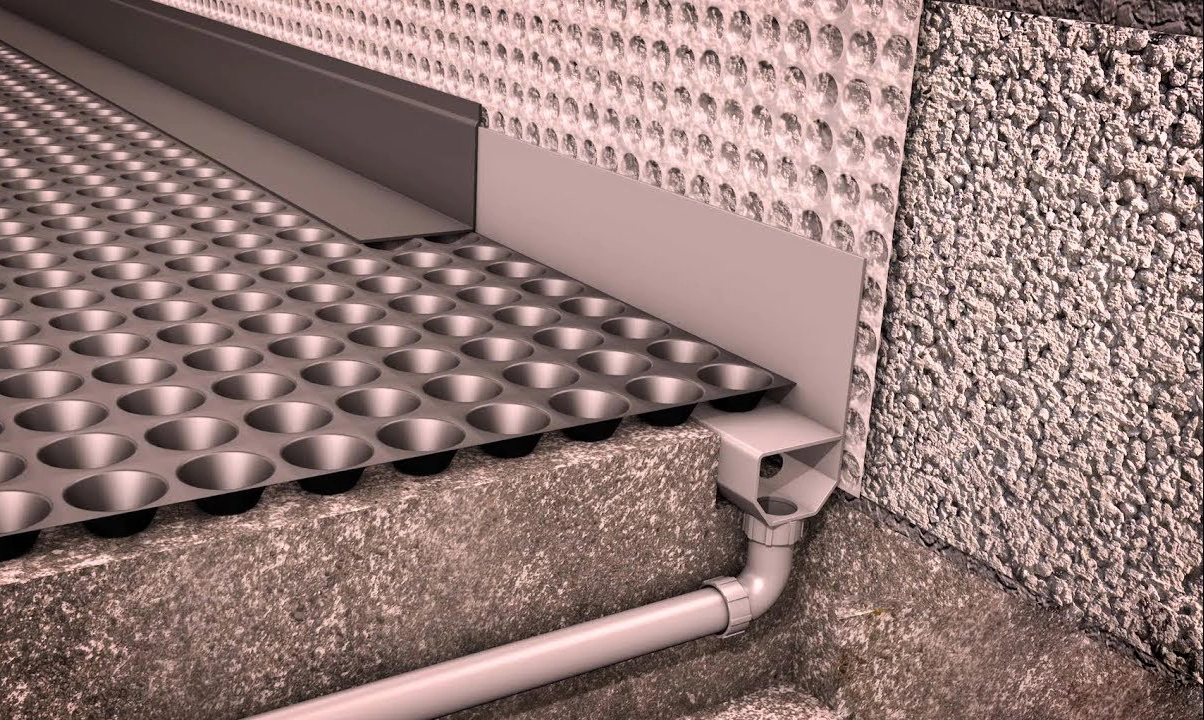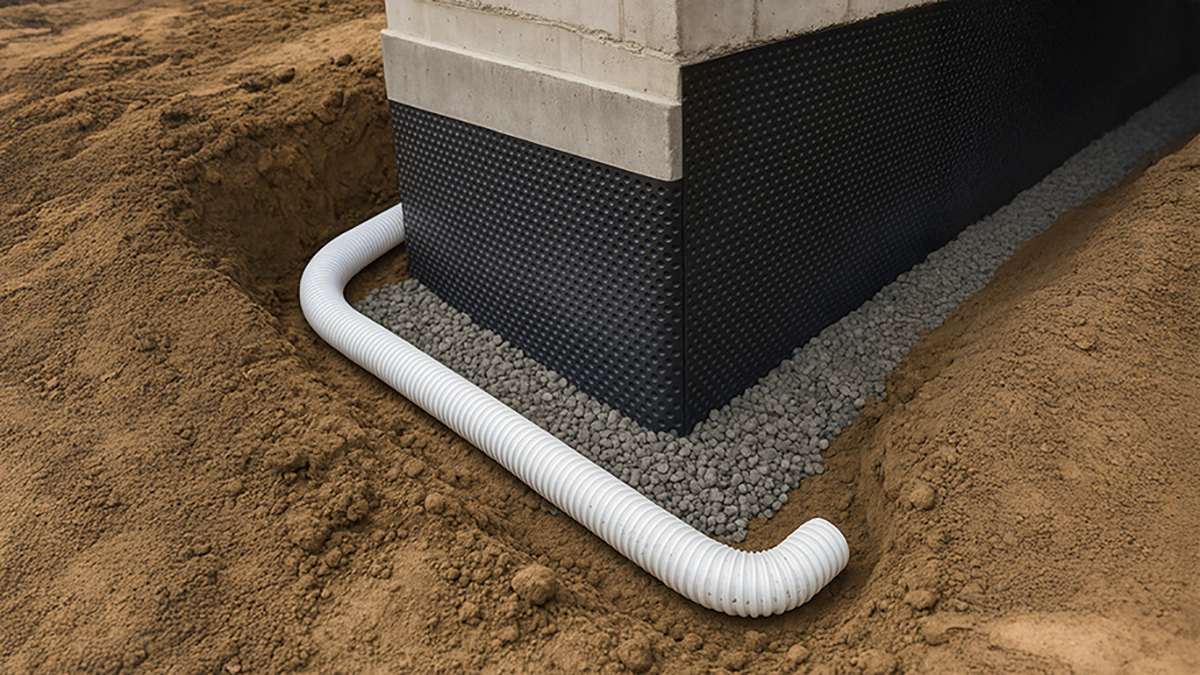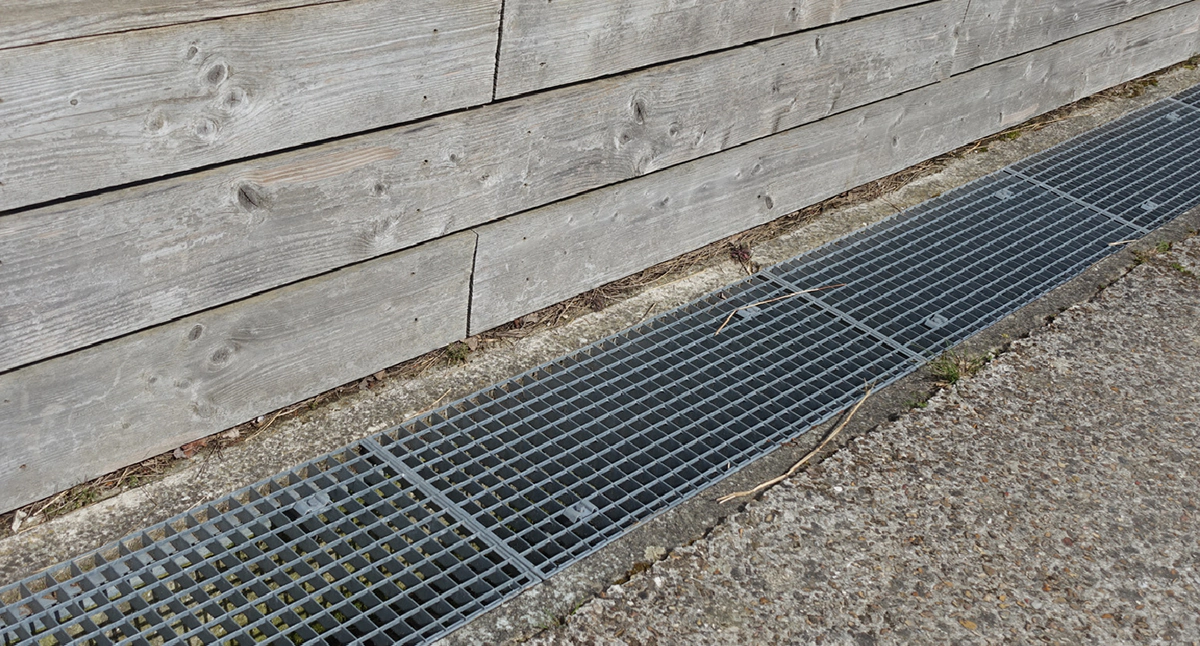Basement moisture and water damage are among the most common problems homeowners face—especially in areas with heavy rainfall or poor soil drainage. One of the most effective ways to manage groundwater around your foundation is through a foundation drainage system, also known as a weeping tile. This guide explains what it is, how it works, the main types, and how proper waterproofing protects your home from long-term structural issues.
Understanding Drainage Systems
Before diving into specific types, it’s important to understand what a drainage system does and why it’s essential for protecting your home’s foundation. These systems work to control the flow of groundwater and prevent moisture from seeping into the basement.
What Is a Drain Tile?
A drain tile system is a network of perforated pipes installed around or beneath the foundation to redirect groundwater away from the structure. Despite the name, modern systems are typically made of PVC or flexible plastic, not clay. Their main function is to relieve hydrostatic pressure and prevent water from pooling near basement walls.
How Does the System Work?
It collects excess water that accumulates in the soil around your home. The perforated pipe allows moisture to flow inside, where it’s directed toward a sump pump, storm drain, or gravel bed for safe discharge. This keeps the foundation dry and helps prevent leaks, cracks, and damp conditions in basements.
What Is Weeping Tile and How Is It Used?
The term weeping tile refers to the same system. Early versions were made of terracotta clay and allowed water to “weep” through small holes. Modern installations use durable plastic pipes surrounded by gravel and filter fabric to prevent clogging and increase efficiency.
Types of Foundation Drainage
Different drainage systems serve unique purposes depending on your home’s layout, soil conditions, and the severity of water issues. Understanding these variations helps homeowners choose the right solution for long-term protection.
Exterior Foundation Drain Tile
Installed outside the foundation at footing level, exterior drainage is one of the most effective methods to prevent water from entering the basement. It requires excavation around the perimeter and is usually done during new construction or major renovation projects.
Interior Basement Drainage Tile
An interior waterproofing system is installed beneath the basement floor. It collects any water that seeps through the concrete and channels it toward a sump pump. This method is ideal for existing homes, since it avoids exterior excavation while still managing groundwater effectively.
French Drains and Yard Drainage Options
A French drain is a surface or subsurface system used around homes and in yards. It directs surface runoff away from the property, preventing soggy soil and foundation pooling. While not directly tied to the basement, it works on the same principle as other foundation drainage solutions.

Benefits of Proper Foundation Drainage
A well-functioning drainage system provides multiple advantages beyond just keeping your basement dry. It helps preserve structural stability, reduces repair costs, and improves indoor air quality over time.
Preventing Basement Leaks and Water Damage
By controlling groundwater and preventing it from pressing against foundation walls, a drainage system reduces the risk of leaks, dampness, and mold growth.
Protecting Against Soil Pressure and Cracks
Constant soil moisture causes expansion and contraction, which can lead to cracks in the concrete. A well-installed waterproofing system stabilizes the soil and helps preserve structural integrity.
Enhancing Overall Home Moisture Control
Proper drainage improves indoor air quality by reducing humidity and mold spores. It also protects basement flooring, insulation, and stored items from long-term moisture exposure.
Installation and Replacement
Whether you’re installing a new drainage line or replacing an outdated one, the process must be handled carefully to ensure effectiveness and compliance with local codes.
How It’s Installed Around a House
Installing a foundation drainage system involves excavating around the home (for exterior setups) or cutting the floor perimeter (for interior versions). The perforated pipe is laid on a gravel bed, wrapped in filter fabric, and connected to a sump pit or discharge line. Afterward, the trench is refilled, and waterproof membranes are applied to the walls.
Over time, systems can clog or collapse due to soil movement, debris buildup, or root intrusion. Warning signs include:
Signs You May Need to Replace Drain Tile
- Persistent dampness or standing water in the basement
- Cracks in foundation walls
- Musty odors or mold
- Sump pump running constantly
If these issues appear, replacement may be the most effective long-term solution.

Drain Tile Maintenance and Care
Even the best drainage system requires some level of maintenance to keep working efficiently. Regular inspection and cleaning can prevent clogs and costly water problems later.
How to Keep Your Drain Tile System Working Efficiently
Regular upkeep ensures your drainage performs well for decades. Homeowners should:
- Clean the sump pump at least once a year
- Check that discharge lines remain clear
- Maintain proper exterior grading away from the house
Occasional inspections by waterproofing professionals can help identify problems before they escalate.
Common Problems and How to Fix Them
Typical problems include clogging, pipe collapse, or improper slope. Minor blockages can be flushed with water jets, while major damage may require partial replacement. Using quality materials and proper installation methods prevents most of these issues.
Final Thoughts
A foundation drainage system—whether interior, exterior, or French-style—is one of the most effective and lasting ways to protect your home from water damage. It helps prevent leaks, relieves soil pressure, and maintains a dry, healthy basement environment.
If your home shows signs of moisture problems, contact a professional waterproofing contractor for an assessment. With proper design, installation, and maintenance, your system can safeguard your foundation for decades.

 CLOGGED OR BROKEN WEEPING TILE
CLOGGED OR BROKEN WEEPING TILE